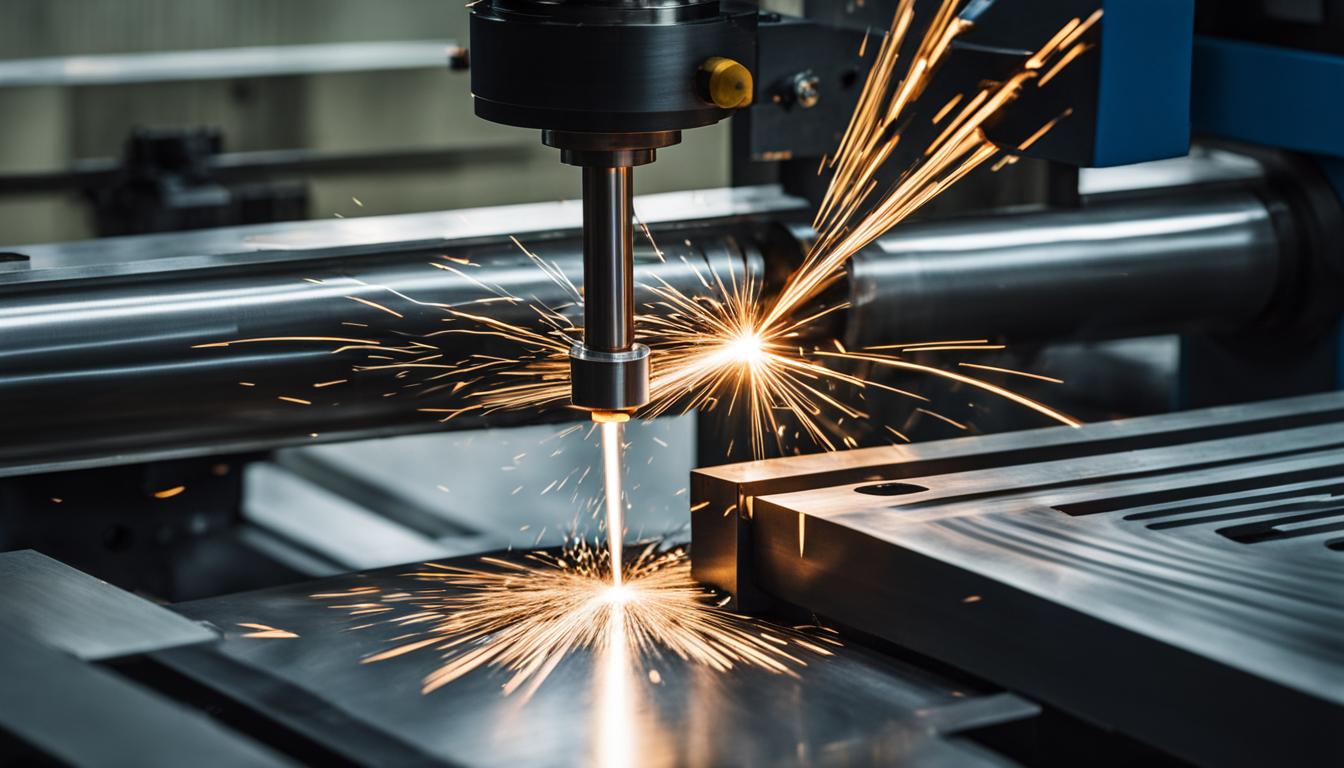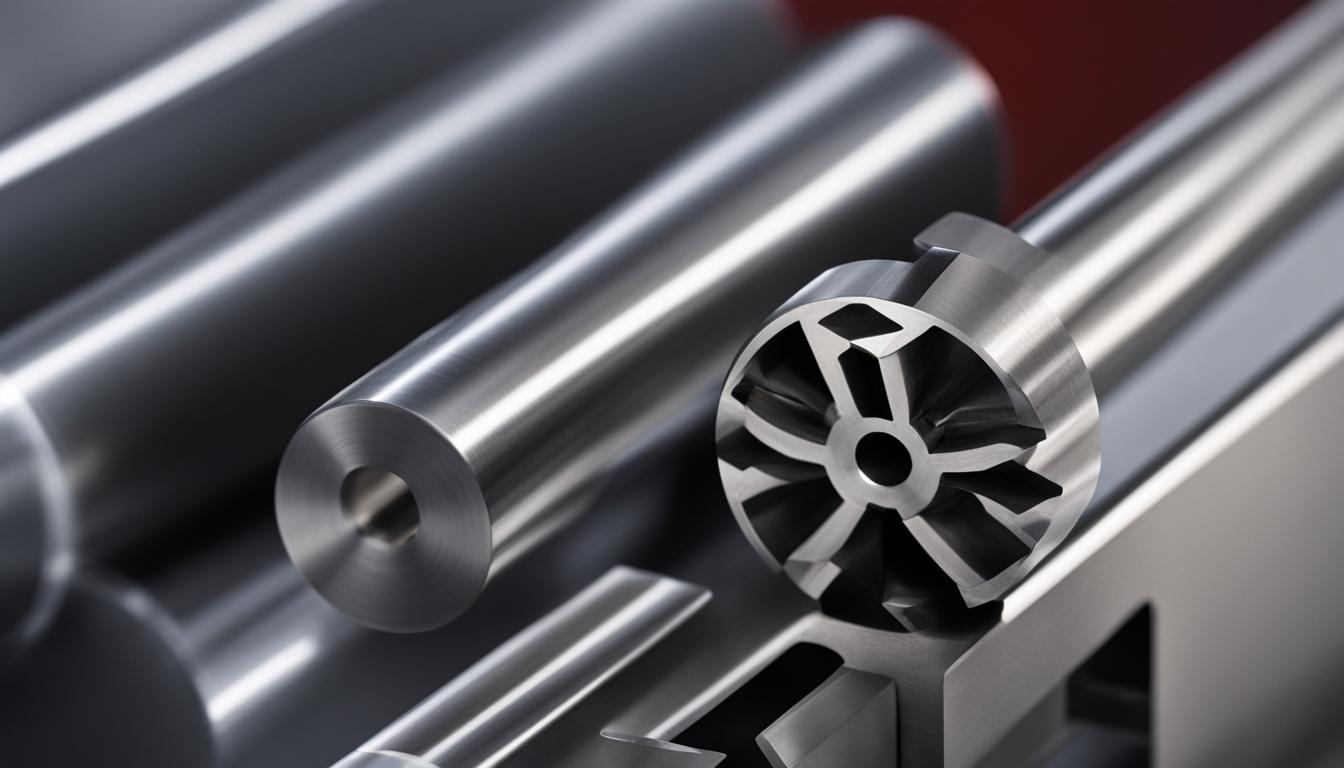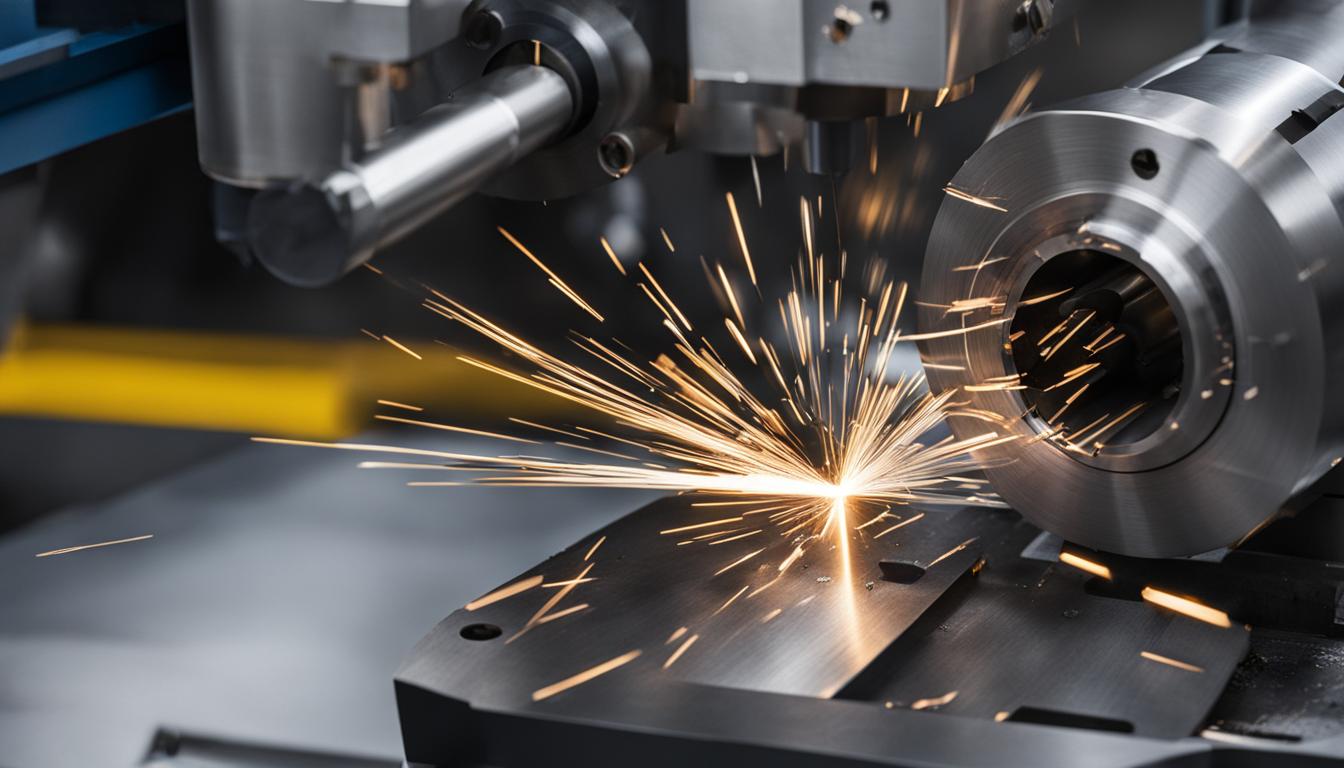Desktop CNC lathes, such as the 8L CNC Lathe by Tormach, offer a wide range of capabilities for small-scale machining needs. Whether you are a hobbyist, enthusiast, or professional, these precision machines provide user-friendly features designed for various applications. The 8L CNC Lathe, for example, is perfect for prototyping and light production, with diverse material handling capabilities and a compact design that fits well in space-constrained environments.
When investing in a desktop CNC lathe, it is important to know what to expect in terms of features and specifications. Let’s explore the key features that make the 8L CNC Lathe a versatile and efficient machine.
- Desktop CNC lathes are precision machines for small-scale machining needs.
- The 8L CNC Lathe is suitable for prototyping and light production.
- It offers diverse material handling capabilities and a compact design.
- The 8L CNC Lathe operates on a standard 120VAC 15A wall outlet.
- Key features include spindle speed, maximum workpiece length, and maximum swing over bed and carriage.
Features of the 8L CNC Lathe
The 8L CNC Lathe offers a wide range of features that enhance its functionality and provide numerous advantages for users. Whether you’re a hobbyist, enthusiast, or professional, this CNC lathe is designed to meet your needs with precision and efficiency. Let’s explore the key features that set the 8L CNC Lathe apart:
1. Diverse Material Handling Capabilities
The 8L CNC Lathe excels in handling a variety of materials, from challenging metals like titanium to softer materials like aluminum and plastics. Its advanced cutting capabilities ensure precise and accurate machining, allowing you to create intricate designs with ease.
2. Compact Design for Limited Spaces
With its compact design, the 8L CNC Lathe is perfect for workshops, garages, labs, and classrooms with limited space. You don’t need a large dedicated area to accommodate this machine, making it ideal for small-scale operations without compromising on performance or functionality.
3. Convenient Operating Environment
The 8L CNC Lathe operates on a standard 120VAC 15A wall outlet, providing convenience and flexibility in various environments. You can set up and use the machine without requiring specialized power sources or extensive electrical modifications.
4. PathPilot CNC Controller
The 8L CNC Lathe is compatible with the PathPilot CNC controller, which offers a user-friendly interface and reduces the learning curve for beginners. This controller also provides advanced capabilities for experts, allowing you to maximize the full potential of the machine.
With its diverse material handling capabilities, compact design, convenient operating environment, and PathPilot CNC controller, the 8L CNC Lathe empowers users to achieve precision and efficiency in their machining projects. Whether you’re a novice or an experienced machinist, this CNC lathe is a valuable tool that delivers exceptional results.
Customer Projects with the 8L CNC Lathe
Witness the impressive performance and precision of the 8L CNC Lathe through the captivating projects brought to life by our valued customers. These projects, showcased on popular platforms like Instagram, exemplify the meticulous craftsmanship and high-quality results achievable with this exceptional machine. Packed with features designed to meet the diverse needs of hobbyists, enthusiasts, and professionals, the 8L CNC Lathe enables the creation of intricate details with unmatched accuracy.
From intricate decorative pieces to perfectly machined mechanical components, the 8L CNC Lathe consistently delivers outstanding CNC lathe performance. This highly precise machine allows for the creation of high-quality parts and products, meeting the exacting standards of even the most discerning craftsmen. Whether you’re a hobbyist working on a personal project or a professional seeking perfection in your creations, the 8L CNC Lathe is sure to exceed your expectations.
Introduction to CNC Turning and Lathe Machines
CNC turning is a subtractive manufacturing technology used to produce cylindrical parts from various materials. Unlike CNC milling, which involves moving the workpiece and the tool simultaneously, CNC turning rotates the workpiece while introducing a stationary cutting tool into the material.
With its versatility, CNC turning can include milling functionality for the production of complex parts. CNC turning machines are available in both vertical and horizontal configurations, providing different options for material handling and machining techniques.
One of the key components of CNC turning is the CNC lathe machine. These machines, sometimes referred to as turning centers, are capable of automatically machining cylindrical parts with high precision and accuracy.
One of the key features of CNC lathe machines is the ability to program them using CNC lathe software. This software allows operators to input specific instructions and commands, enabling precise control and automation of the machining process.
By using CNC lathe software, operators can define the toolpaths, set the cutting parameters, and optimize the machining operations for achieving the desired results. This level of control enhances productivity and ensures consistency in the production of cylindrical parts.
Additionally, CNC lathe machines offer various options and configurations to meet different machining requirements. These options include different spindle sizes, turret configurations, and automatic tool changers, allowing for increased versatility and flexibility in the machining process.
Overall, CNC turning and lathe machines provide the capability to produce high-quality cylindrical parts with ease and precision. The combination of CNC lathe software and machine options opens up a world of possibilities for manufacturers and enables them to achieve efficient and accurate production.
| Pros | Cons |
|---|---|
| CNC turning offers precise and accurate machining of cylindrical parts. | The initial investment for CNC lathe machines and software can be relatively high. |
| The automation and control provided by CNC lathe software improve efficiency and consistency in production. | Operating and programming CNC lathe machines require specialized knowledge and training. |
| CNC lathe machines can handle a wide range of materials, including metals and plastics. | The size and weight of CNC lathe machines may limit their use in certain spaces. |
| CNC lathe machines offer various options and configurations to meet different machining requirements. | CNC lathe machines may not be suitable for all types of machining operations, such as those requiring multidirectional tool movement. |
Types of Operations in CNC Turning
In CNC turning, a variety of operations can be performed to achieve precise and efficient machining results. These operations include facing, turning, drilling, boring, threading, grooving or parting, and knurling. Each operation serves a specific purpose in the manufacturing process, utilizing different tools and techniques to shape the workpiece.
Facing: This operation involves cutting the workpiece’s end face to create a smooth, flat surface.
Turning: Turning is the process of removing material from the workpiece’s outer surface to achieve the desired shape and diameter.
Drilling: Drilling is the operation that creates cylindrical holes in the workpiece using a rotating drill bit.
Boring: Boring is similar to drilling but is used to enlarge existing holes or create larger diameters.
Threading: Threading is the process of cutting threads onto the workpiece to enable it to be screwed onto other parts.
Grooving or Parting: Grooving or parting involves cutting a groove or separating the workpiece into two parts, respectively.
Knurling: Knurling is the process of creating a textured pattern on the workpiece’s surface to improve grip or aesthetics.
CNC turning machines, such as the 8L CNC Lathe, offer the functionality to perform these operations accurately and efficiently. The specifications of the desktop CNC lathe, including maximum workpiece length and maximum swing over bed and carriage, determine the size and complexity of the parts that can be machined.

With its range of operations and the precise control it offers, CNC turning is a versatile and effective method for machining various parts and components.
Advantages of CNC Turning
CNC turning offers several advantages over traditional manual turning. One of the key advantages is the high precision and accuracy achieved through automation and computer control of the machining process. CNC turning machines, such as the 8L CNC Lathe, can produce extremely precise parts with consistent quality and repeatability. This level of precision ensures that the final products meet the desired specifications and tolerances.
Another advantage of CNC turning is its flexibility in producing a wide range of complex parts. With advanced programming capabilities and tooling options, CNC turning machines can tackle intricate designs and achieve intricate geometries. This makes CNC turning suitable for both prototyping and small-scale production, where versatility is crucial.
CNC turning machines also offer enhanced operator safety compared to manual turning machines. The cutting process takes place behind machine guards, reducing the risks associated with direct contact between operators and cutting tools. This safety feature ensures a secure working environment and protects operators from potential accidents.
With these advantages, CNC turning machines, like the 8L CNC Lathe, deliver superior CNC lathe performance and CNC lathe precision, making them a valuable asset in various industries, including manufacturing, automotive, aerospace, and medical.
Advantages of CNC Turning
| Advantages |
|---|
| High precision and accuracy |
| Flexibility for complex parts |
| Enhanced operator safety |
Considerations for CNC Machine Accuracy and Performance
Achieving CNC lathe performance and precision requires careful consideration of several factors to optimize the accuracy and overall machine performance. By taking these factors into account, users can ensure that their CNC machines meet their specific needs and deliver high-quality results.
Establish Goals
Before delving into CNC machine accuracy and performance, it is essential to establish clear goals. Consider the machine’s capacity, desired CNC capabilities, and the required levels of accuracy and speed. Setting specific goals will guide the machine selection and configuration process and help align expectations with the machine’s capabilities.
Rigidity for Stability
Rigidity plays a crucial role in CNC machine performance. Choosing materials such as cast iron and granite for the machine’s construction provides the necessary stability to minimize vibrations and ensure accurate machining. A rigid machine foundation enhances cutting performance and helps deliver precise and repeatable results.
Friction, Accuracy, and Backlash
Friction, accuracy, and backlash are critical considerations for CNC machine design. Friction can affect the smooth movement of machine components, impacting precision and overall performance. Accuracy depends on the machine’s mechanical and control systems, such as the accuracy of the leadscrew, encoder resolution, and the CNC controller’s capabilities. Backlash, or the amount of play between moving parts, should be minimized to maintain positional accuracy.
By addressing these considerations and optimizing the CNC machine’s rigidity, friction, accuracy, and backlash, users can enhance accuracy and performance, achieving the desired precision for their machining needs.
| Consideration | Description |
|---|---|
| Rigidity | Choose materials like cast iron and granite for the machine’s construction to provide stability, minimize vibrations, and enhance cutting performance. |
| Friction | Take into account the smooth movement of machine components by considering and minimizing friction. |
| Accuracy | Ensure mechanical and control systems, such as the leadscrew accuracy, encoder resolution, and CNC controller capabilities, meet the required level of accuracy. |
| Backlash | Minimize the amount of play between moving parts to maintain positional accuracy and prevent backlash. |
Addressing these considerations will optimize CNC machine performance, enhancing accuracy, precision, and overall machining results. By carefully evaluating and selecting a CNC machine that meets the desired requirements, users can ensure successful outcomes for their machining projects.

Setting Realistic Goals for CNC Machine Accuracy
When it comes to CNC machine accuracy, setting realistic goals is crucial to ensure optimal performance and satisfactory results. The achievable accuracy of a CNC machine can vary depending on several factors, including the materials being cut and the complexity of the parts. It’s important to consider these factors when determining the level of accuracy required for your intended applications and machining requirements.
Factors such as machine rigidity, backlash, and friction can influence the achievable accuracy of a CNC machine. Rigidity plays a significant role in machine performance, as it determines the machine’s ability to maintain stability and precision during cutting operations. By prioritizing rigidity and considering the impact of these factors, users can make more informed decisions about the accuracy levels they can realistically achieve.
For most hobbyist and small-scale production purposes, an accuracy level of 0.001″ is considered ideal. This level of accuracy can meet the needs of precision machining, ensuring that the final parts meet the required specifications. By setting realistic goals in terms of accuracy, users can avoid unnecessary frustration and ensure that their CNC machine’s performance meets their expectations.
The specifications of desktop CNC lathes, such as the 8L CNC Lathe, can provide valuable insights into the achievable accuracy of the machine. These specifications help users understand the machine’s capabilities and align their goals accordingly. By considering the desktop CNC lathe specifications, users can make informed decisions about the level of accuracy they can expect from their machine and adjust their goals accordingly.
Setting realistic goals for CNC machine accuracy is essential for achieving satisfactory results. By considering the materials being cut, the complexity of the parts, and the machine’s rigidity, users can determine the achievable accuracy level and ensure that their goals align with the capabilities of their CNC machine.
Importance of Rigidity for CNC Machine Performance
Rigidity plays a crucial role in determining the performance of CNC machines, particularly CNC lathes. The level of rigidity directly impacts the accuracy and stability of the machine during cutting operations, ultimately affecting the quality of the produced parts.
In the construction of CNC machines, materials known for their high rigidity and vibration-dampening properties, such as cast iron and granite, are widely used. These materials provide the necessary stability and reduce unwanted vibrations that can compromise the precision of the machining process.
To further enhance rigidity, design modifications can be made, and additional components can be integrated into the machine. Stronger clamps and improved support systems are examples of components that can be utilized to improve rigidity.
By prioritizing rigidity in CNC machines, users can ensure optimal performance and the production of precise, high-quality parts. CNC lathe features and functionality are greatly influenced by the rigidity of the machine, making it a critical consideration for users seeking superior results.
